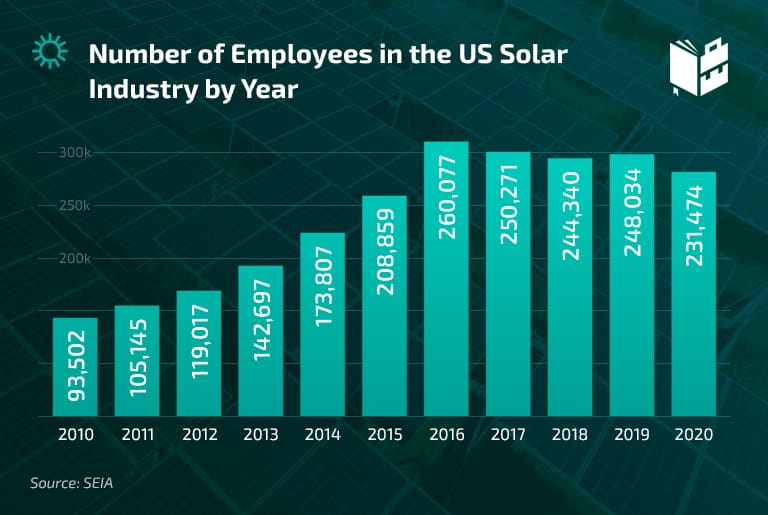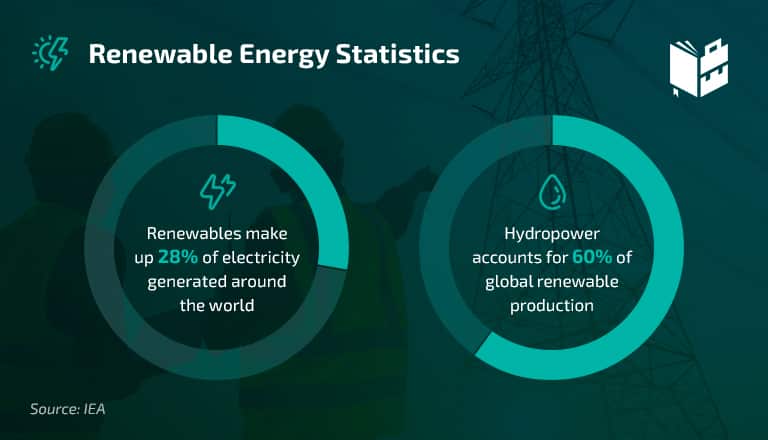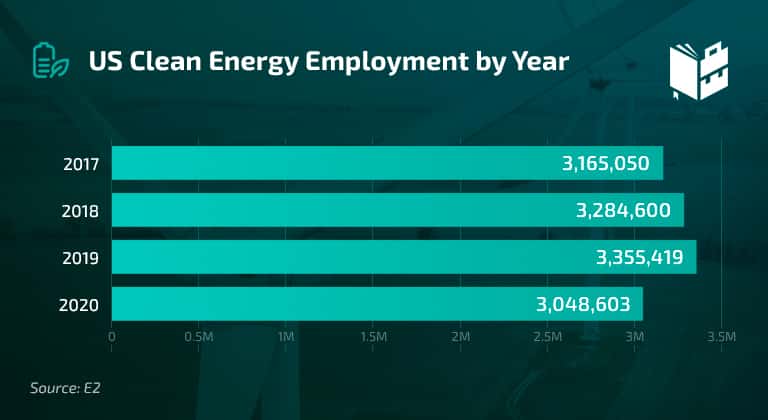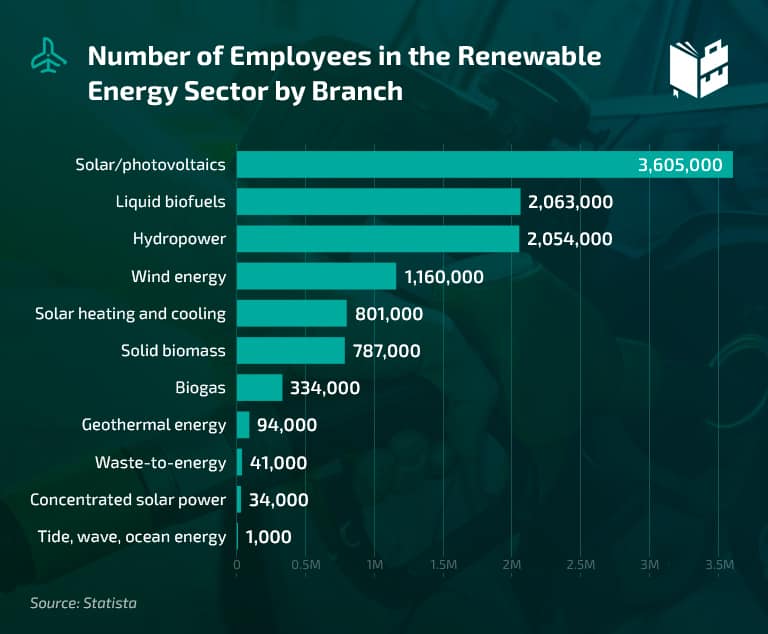Renewable energy job creation statistics claim 11.5 million people around the world work in the renewable energy sector. Relying on renewable energies instead of fossil fuels means reducing greenhouse gases and other types of environmental pollution.
The growth of investment in renewable energy causes an unprecedented creation of jobs in the sector. This rising employment helps governments address a basic economic problem that both developed and developing countries have.
That’s why we’ll bring you all the facts and figures about the employment generation capacity in this industry.
Let’s delve in deeper.
Renewable Energy Employment Statistics (Editor’s Choice)
- Men hold 68% of clean energy jobs.
- China has the most wind energy jobs in the world (44%).
- The average annual salary of solar panel installers is around $46,470.
- Renewables account for 28% of electricity generated around the world.
- 1.15 million people are employed in the wind industry worldwide.
- India employs the second-highest number of people in the global hydropower industry.
- Iceland is the greenest country in the world, with nearly 100% of its electricity coming from renewables.
- Global investment in renewables can create 42 million jobs by 2050.
Global Renewable Energy Employment Statistics
1. 4.4 million renewable energy jobs exist in China.
(IRENA)
The renewable energy sector is emphatically breaking into the Asian countries, creating thousands or even millions of job opportunities. In addition, China is the leader in renewable energy employment worldwide with over four million workers.
Brazil, the US, India, France, Bangladesh, Germany, Indonesia, Japan, and Colombia are also world leaders in using renewable energy and employment growth in the sector.
2. According to the latest data, solar power employs more than 43% of people in the electricity generation industry in the US.
(Forbes)
You might be wondering — how many jobs are there in renewable energy? Currently, the solar industry workforce in the United States is bigger than that of the oil and gas sectors. What’s more, it’s nearly triple the size of all workers employed in coal mining.
While the solar energy sector employs almost half of workers in the electricity generation industry, the combination of all other fossil fuel-based sectors (coal, oil, and gas) employs just 22%. And we haven’t even started talking about wind, biofuel, and others.
3. The US solar industry employs 231,474 workers.
(SEIA)
If you want to know whether there are more jobs in renewable energy now than in previous years, keep in mind that most states’ employment in the US solar industry fell by 6.7% due to the pandemic. However, despite this job decline, the solar industry installed record levels of solar capacity. As a result, the workers’ productivity increased by up to 32%.

4. Brazil creates the highest number of jobs in the biofuel industry — 839,000.
(IRENA)
In the entire clean energy industry, Brazil comes second in the area of job creation. Moreover, the South American country generates the most liquid biofuel jobs (34%).
5. 68% of clean energy jobs are taken by men.
(The Borgen Project)
A 2021 US energy and employment report shows that the percentage of women who take renewable energy jobs stands at 32%, less than half of their male counterparts. Generally, there are fewer women in the energy industry, especially in the blue-collar category.
6. China has the most wind energy jobs in the world (44%).
(IRENA)
Asia’s 648,000 wind jobs make up 56% of 1.17 million wind jobs worldwide. As the leading country for new wind installations, China’s wind-related employment is steady. According to renewable energy employment statistics, this country is the leading producer of jobs in the solar PV industry and the wind technology industry.
China takes the largest share of 44%, with around 518,000 jobs. In second place is Germany with about 121,700 jobs. The United States comes third with approximately 120,000 jobs.
7. The average annual salary of solar panel installers is around $46,470.
(BLS)
According to the Bureau of Labour Statistics, a solar panel installer is a good job. But does renewable energy create jobs that pay well? You should know that this job is in the skilled labor category and has a salary of 22.34 dollars per hour on average.
Moreover, solar photovoltaic (PV) installers’ employment is projected to grow 51% by 2029, much faster than the average for all occupations.
8. Renewables make up 28% of electricity generated around the world.
(IEA)
Renewable energy job creation statistics show that renewable energy makes up almost a third of energy generation globally. However, much of that number comes from hydropower that accounts for 60% of global renewable generation.

9. Latest data shows that the solar PV industry is the largest employer of labor, with 3.37 million employed people.
(IRENA)
The Photovoltaic industry has been the biggest employer of labor in the clean energy industry as of 2017, according to a 2017 US energy and employment report. This industry employs over 3 million people, many of whom are from Asia.
In addition, the Liquid Biofuel industry (1.9 million workers) has more laborers than hydropower (1.5 million workers). Next on the list are Solar Photovoltaic, Bioenergy, Wind Energy, Solar Heating/Cooling, Solid Biomass, Biogas, Hydropower, Geothermal Energy, CSP, Municipal and Industrial waste, and Tide, Wave & Ocean Energy.
10. 1.15 million people worldwide are employed in the wind industry.
(Forbes)
The solar and wind industries are spearheading the alternative energy job growth coming from the global clean energy industry. After the solar photovoltaic industry, the wind energy industry is the second biggest employment creator, taking the position from biofuel over the last few years.
However, the wind sector holds just one-third of the workers in the photovoltaic industry. Moreover, 84% of all the jobs in the wind industry are concentrated in China, Europe, and North America.
11. India employs the second-highest number of people in the global hydropower industry.
(IRENA)
According to global renewable energy job creation statistics, approximately 1.93 million people are employed in the hydropower part of the renewable energy sector. Among these, 19% are people from India. China is first with 29%, while 11% belong to Brazil and 4% to Vietnam.
12. Most recent info suggests that 38% of global clean energy jobs are in China.
(IRENA)
According to clean energy jobs statistics, China is a global renewable energy sector powerhouse. For example, China’s solar PV workforce counts 2.2 million people. In addition, the Chinese solar water heating industry has around 670,000 jobs.
13. Iceland is the greenest country globally, with nearly 100% of its electricity coming from renewables.
(Warp News)
The small European country runs a clean energy economy. It generates and supplies the cleanest electricity per person in the world.
Interestingly, 87% of this energy comes from hydropower. Since Island has many glaciers and mountains, it is perfect for hydroelectric generation. Moreover, as one of the most active volcanic regions in Europe, Iceland has all types of geothermal activities. So, 13% of the country’s electricity comes from geothermal power.
14. 11.5 million people are employed in the renewable energy sector worldwide.
(IRENA)
If you want to find out how many jobs renewable energy creates, you should check a new report from the International Renewable Energy Agency (IRENA). You will see that the current numbers represent a substantial growth from the previous year’s figure of 11 million.
15. 67,000 more renewable jobs are created in the European Union.
(EurObserv’ER)
As many as 20 European members increased or maintained the number of renewable jobs. As a result, employment in the renewable energy sector in Europe has increased by 4.6%, based on the most recent data available.
In fact, the greatest renewable job growth is in Bulgaria (+18,400 new jobs, or +81%), Austria (+14,900 new jobs, or +62%), and Poland (+11,900 new jobs, or +16%). Still, the European Union members with the highest renewable job employment rate are Germany, Spain, France, and Italy.
16. Germany has 309,000 renewable energy jobs.
(IRENA, Climate Action Tracker)
According to the latest available renewable energy job creation statistics, renewable energy employment in Germany has gradually declined over the last decade. Nevertheless, the country had the most jobs in the sector in 2011 (416,700).
Regardless of the decline, Germany remains the European country with the largest number of renewable energy jobs. What’s more, it has recently set the goal to raise the share of electricity generated from renewable energy to 65% electricity generation by 2030.
17. Around 3.8 million people work in the solar energy sector.
(IRENA)
As can be verified by the solar energy job growth report from IRENA, the bulk of employment is in the solar energy sector. It’s followed by biofuels that employ more people in countries such as Indonesia and, finally, wind.
Subsectors in the renewable energy technology sector include the solar energy industry, biofuel industry, geothermal industry, and wind energy industry.
18. The Spanish renewable energy sector contains only 167,100 jobs.
(EurObserv’ER)
Renewable energy job creation statistics show that renewable employment in Spain is 11% of the total number of jobs in the European Union renewable energy sector. Sadly, in recent years, there has been a systematic destruction of jobs in the renewable sector in Spain, whereas more jobs have been created in most countries.
19. Offshore wind energy provides around 7% of the UK’s energy.
(ITV)
One of the most used renewables is wind. The wind at sea and on land is used all over the world. According to clean energy jobs statistics, offshore wind farms are extremely effective in the UK, and the use of wind will increase by 2030.
In addition, deals in the wind sector are projected to produce around one-third of the UK’s electricity power needs before 2030. So, the government is ready to throw its weight behind power generation from offshore wind.
20. Most people in the Turkish renewable energy sector work in the hydropower industry — 34,400.
(Statista, Statista)
Turkey has the second-largest hydroelectric capacity in Europe with 28,503 MW. So, it’s no wonder the hydropower industry has the largest share of full-time renewable energy jobs.
Renewable Energy Jobs in the USA
21. In 2019, solar energy contributed to 1.7% of the total electricity consumed in the United States.
(Globe Newswire)
This also affected job creation in the sector. Although the figures show an overall fall in employment generation, there have also been increases in the solar energy sector in 29 of the 50 states of the country, with Florida leading the pack.
22. There are roughly 3 million green jobs in the US.
(E2)
If you want to know how many green jobs there are in the US, have in mind that the clean energy industry is one of the fastest-growing employment-creating industries in the US. However, this industry has lost 307,000 workers recently, according to the newest report published by E2.
The overall number of green jobs in the US decreased from 3.36 million in the previous year. In fact, California, Texas, New York, and Florida remain the leaders for clean energy jobs nationwide.

23. Jobs in the field of solar energy have risen by 167% in the United States over the last decade.
(CNBC)
As renewable energy employment statistics for the US show, solar energy is going through a boom moment. In the United States, the number of jobs linked to the sector has soared in the last ten years.
Today, more people are working on solar energy than on oil platforms and gas fields. Moreover, you wouldn’t need experience from other related industries to work in the solar field; a high school diploma is enough for prospective workers.
24. According to the latest data, solar energy employs 2x as many people as coal in the United States.
(Solar Power World)
People often bring up the coal jobs vs. renewable energy jobs capacity debate. However, according to a report prepared by the National Association of State Energy Officials and the Energy Futures Initiative, there are more than twice as many jobs in solar energy than in the coal industry in the US.
25. 231,474 people are employed in the solar energy industry.
(IREC USA, WRI)
Just a year before, there were nearly 248,034 employees in the US solar energy industry. In addition, renewable energy job growth by year in the United States data shows that the solar industry will reach 400,000 jobs by 2030 and 900,000 by 2035.
In comparison, the number of jobs in the coal generation sector fell to 79,711.
26. The PV installer job will be the fastest-growing job in the US in 2026.
(Daily Energy Insider)
A couple of years ago, experts predicted that the photovoltaic solar installer job would be the fastest-growing job in the US in the next 10 years. According to renewable energy job creation data from the Bureau of Labor Statistics, the growth rate is set at 105.3%, much faster than the average for every other occupation.
27. The US hydropower industry employs up to 300,000 workers, from project development and manufacturing to facilities operations and maintenance.
(Hydro)
The country’s hydropower has a lot of potential to expand its labor force. The US has the second-largest installed capacity of hydropower in the world at 100GW, including pumped storage facilities.
A recent renewable energy employment statistic for the US reveals that the US hydropower industry can reach its job creation potential with the right policies in place. In other words, it will happen when policies such as a renewable electricity standard are deployed.
According to new findings, 1.4 million renewable jobs can emerge in the US hydropower industry by 2025.
28. Renewable energy generation jobs increased the rural workforce by 20%.
(WRI)
Statistics tell us renewable energy generation jobs grew the fastest of all clean energy jobs. So, there are 8,252 more jobs in the industry. On the other hand, urban counties added only 7,000 renewable energy jobs.
Job Growth Statistics in the Clean energy Industry
29. Latest data shows that job growth due to renewable energy is 5.3%.
(IRENA)
The renewable energy sector is the future of work in the energy industry. In fact, global renewable energy employment reached 10.3 million jobs. Since then, the situation has changed significantly for the better, reaching the highest number of renewable energy jobs ever.
30. Most recent info suggests that over 10 million people are employed in the clean energy industry.
(Forbes)
If you want to find out whether the renewable energy industry is growing, you should know that the total number of people employed in the renewable energy technology sector has gained over 2 million new jobs in three years.
However, IRENA’s latest annual review figure shows even higher job growth rates than in IRENA’s renewable energy and jobs annual review from 2018. Nowadays, the renewable energy sector has reached approximately 11.5 million jobs, according to job statistics.
31. The last accessible statistic shows that renewables make up 17.1 percent of electricity generation.
(C2ES)
Out of that percent, hydro, wind, and biomass make up the majority. However, they are expected to rise to 24 percent by 2030, increasing the number of jobs created by renewable energy. Moreover, most of the increase is projected to come from solar and wind. In addition, non-hydro renewables have raised their share of electric power generation from less than 1% to almost 10.1%.
32. The number of jobs in the global photovoltaic industry has exceeded 3 million.
(Forbes, Statista)
The biggest industry in the clean energy sector is the solar photovoltaic industry. According to energy sector employment statistics, the number of employees in this industry has grown by 9%, rising to 3.4 million.
Another 800,000 people are employed in solar power directly converted to heating or cooling. Moreover, 34,000 people work in concentrated solar power.

33. There was a 0.4% increase in the US clean energy jobs in 2020.
(E2)
Clean energy created about 190,000 jobs in the US in 2018 and 2019. Since then, there have been terrible job losses. In the COVID-19 aftermath, September is the fourth month of job growth for the industry. Recent renewable energy and jobs findings say that 12,479 clean energy jobs added in September 2020 signal some national clean job growth.
However, almost 14% of the sector’s pre-COVID-19 workforce is unemployed. As a result, instead of adding more than 175,000 jobs in 2020, only one in five lost clean energy jobs came back.
34. The top five producers of photovoltaics hold 90% of jobs in the industry.
(Forbes)
Photovoltaics involves the production of electricity from light through the use of semiconducting materials. The biggest producers are China, Japan, the US, India, and Bangladesh.
Renewable Energy Jobs in the Future
35. There will be 24 million jobs in the global renewable energy sector by 2030.
(The Guardian)
This is up from 9.2 million reported in 2014. It is quite a realistic figure considering the growth of the sector, the international outlook, and the ongoing energy transition towards global decarbonization.
36. 1 out of 50 jobs created in the US is from the solar industry.
(Energy.gov)
If you want to know what types of jobs there are in renewable energy solar sectors, they are the following — panel installers, designers, engineers, sales personnel, and managers. In 2016 alone, the solar sector generated over 73,000 jobs, 25% more than in 2015. This growth trend is likely to continue in the future.
37. Industry leaders predict 400% growth for the renewable energy industry by 2040.
(ClimateAction)
As we can see in existing renewable energy employment statistics and forecasts, the clean energy industry has been growing year after year at a pace that has never been seen before. However, it accounts for only 14 percent of all global energy demand.
38. Global investment in renewables can create 42 million jobs by 2050.
(IRENA)
Jobs in renewables can reach four times their current level if the world keeps investing heavily in them. According to IRENA’s global renewable energy jobs outlook, energy efficiency measures would create 21 million additional jobs.
39. Solar energy can create nearly 2 million jobs in the US market by 2025.
(Forbes)
The potential for job creation in the renewable energy industry in the US is tremendous. As such, this part of the US economy ranks high on President Biden’s agenda. Currently, the US government invests $18.7 billion in the solar energy sector per year.
Consequently, the sector has consistently grown 23% annually for the last five years. If the trend continues, it could reach a 30% annual growth rate by 2025. The sector’s projections for renewable energy job growth are evident.
Conclusion
As automation and robotics are taking away human jobs, the world is bound to benefit more from the 2050 decarbonization goal. Currently, the dependence on fossil fuels in terms of products and employment opportunities is fading out. So the bottom line is that the future of the global energy industry lies in the renewable energy industry.
Greenhouse gas emissions are shifting the planet to unfavorable climate change and global warming precipice. So, the time for individuals and governments to invest in the renewable energy sector is now!